This article needs additional citations for verification .(May 2022) |
The Iraqi vehicle registration plate is a license plate used for official identification purposes for motor vehicles in Iraq.
This article needs additional citations for verification .(May 2022) |
The Iraqi vehicle registration plate is a license plate used for official identification purposes for motor vehicles in Iraq.
Iraq has two official license plate formats. There's one format followed in the Kurdistan Region, and there's another format followed in the rest of Iraq. After months of negotiation, an agreement has been reached between Baghdad and Erbil, where they will unify the design and format of license plates of all governorates of Iraq. [1] Iraqi Kurdistan started issuing the new format for license plates from April 2022. Rest of Iraq are expected to start issuing new license plates in the coming months too.
In 1988, Iraq adopted a new license plate format. This new format applied to all governorates of Iraq.
The license plate was divided in half with a horizontal line. On the bottom right quarter, the name of the country "Al-Iraq" in Arabic is written. On the bottom left quarter, the name of the province in Arabic. On the top of the license plate, there's the registration number.
The color of the plate depended on the classification of the vehicle. Please refer to the section about license plates in Kurdistan Region for more details.
In 2001, the shape and dimensions of the license plates changed, while the general format remained the same. The length of the plate was increased, while its width was reduced. The font of the plate was also changed. The name of the country "Al-Iraq", and the name of the province were moved to the left hand side of the license plate, with the country name above the province name. The coloring and classifications of the new license plates remained unchanged.
The new license plate format was adopted on 2008. The license plate is rectangular in shape and made of aluminum, with a dimension of 335x155 mm. On the left side, the word "Iraq" appears in English, written vertically. There is a horizontal line that divides the license plate into two sections. In the narrower bottom section, the name of the Province is written, plus the classification of the license plate in Arabic. In the top, the registration code is written, large font in Arabic, and underneath it, smaller font in Latin. The license plate now consists of a letter, and a 5-digit numbers. [2]
| Colour | Image | Type | Type in Arabic |
|---|---|---|---|
| White |  | Private vehicle | خصوصي |
 | Motorcycle | دراجة | |
| Red |  | Vehicle for hire, bus, taxi | اجرة |
| Blue |  | Governmental No Province name | حكومية |
| Yellow |  | Trade, e.g. trucks, tractors, cranes | حمل |
| Orange |  | Temporary awaiting Customs Clearance No Province Name | ادخال كمرکي مؤقت |
| Green |  | Agricultural | زراعي |
 | Construction | إنشائية | |
| Black |  | ICTS | جهاز مكافحة الارهاب |
| Letter (Arabic) | Letter (Latin) |
|---|---|
| ا | A |
| ب | B |
| ج | J |
| د | D |
| ر | R |
| س | S |
| ط | T |
| ف | F |
| ك | K |
| م | M |
| ن | N |
| هـ | H |
| ى | E |
| ق | Q |
| ل | L |
| و | W |
| ز | Z |
The format that was introduced in 1988, continued to be used in the Kurdistan Region until 2022 was adopted in 1988 by all of Iraq. However, since from the year 1992, the Kurdistan Region has had de facto, and from the year 2005, also constitutionally-recognized autonomy, the license format changes that affected the rest of Iraq, were not enforced in the Kurdistan Region. This region still continued to use the format from 1988 until 2022.
The license plate is divided in half with a horizontal line. On the bottom right quarter, the name of the country "Al-Iraq" in Arabic is written. On the bottom left quarter, the name of the province in Arabic. On the top of the license plate, there's the registration number. Currently, the provinces of Erbil, Sulaymaniyah and Dohuk use 6-digit numbers. No information exists as of yet on the province of Halabja
The different classes of the license plates are differentiated by the colour of their background. Besides that, there are no texts or different number or letter on each different class of each plate to differentiate them.
| Colour | Image | Type |
|---|---|---|
| Black on White |  | Private vehicle |
| White on Red |  | Vehicle for hire, bus, taxi |
| Black on Yellow |  | Trade, e.g. trucks, tractors, cranes |
| White on Blue | Law Enforcement | |
| Golden on Dark Green | Military | |
| Red on White |  | Temporary |
After months of negotiation between Baghdad and Erbil on the issue of finally unifying the design of license plates across the entire country, finally in Spring of 2022, the two sides reached an agreement. [1] The new license plates are going to be fully in Latin Alphabet, and Governorates of Iraq will be represented by a code, instead of their fully name written out. The switch to Latin and to codes resolves two issues. Firstly, it allows for foreign travel of Iraqi cars without a need to install a special plate, and secondly, it would allow Baghdad and Erbil to fully bypass the question of whether the new plates would be in Arabic or Kurdish.
Starting from April 26, the four governorates of Kurdistan Region started issuing the new format of license plate. The rest of Iraq is expected to follow suit in the coming months. The licence plates will be in Standard European size, for the first time in the entirety of Iraq and its license plate history (520mm x 110 mm). There will be a bar on the left hand side, where the code IRQ, representing Iraq will be shown in a vertical manner, and it will also feature a smaller sized code KR, representing Kurdistan Region.
License plates follow the following format: GG X ####, where GG is a two digit code indicating the Governorate. This format is the first time that Halabja Governorate gets its own representation.
The color format will be identical to the current design that the rest of Iraq use, as shown in the table below. [3] However, the type will not be indicated in text on the license plates.
| Colour | Image | Type |
|---|---|---|
| White |  | Private vehicle |
| Red |  | Vehicle for hire, bus, taxi |
| Blue |  | Governmental |
| Yellow |  | Trade, e.g. trucks, tractors, cranes |
| Green |  | Agricultural |
There are plans to replace all existing license plates with this new format. However, since the letter-digit configuration is about to change, certain rules will apply.
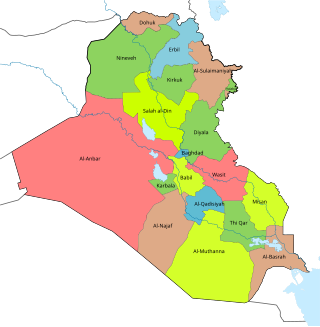
Iraq consists of 18 recognized governorates, also known as "provinces" and 1 partially recognized governorate (Halabja). Per the Iraqi constitution, governorates can form an autonomous region. Four governorates, Erbil, Sulaymaniyah, Halabja and Duhok, constitute the autonomous Kurdistan Region. Baghdad and Basra are the oldest governorates. The second most-populous one, Ninawa is in the upland region and has a cooler climate of the north-west.

A vehicle registration plate, also known as a number plate or license plate or licence plate, is a metal or plastic plate attached to a motor vehicle or trailer for official identification purposes. All countries require registration plates for road vehicles such as cars, trucks, and motorcycles. Whether they are required for other vehicles, such as bicycles, boats, or tractors, may vary by jurisdiction. The registration identifier is a numeric or alphanumeric ID that uniquely identifies the vehicle or vehicle owner within the issuing region's vehicle register. In some countries, the identifier is unique within the entire country, while in others it is unique within a state or province. Whether the identifier is associated with a vehicle or a person also varies by issuing agency. There are also electronic license plates.

Sulaymaniyah or Slemani, is a city in the east of the Kurdistan Region of Iraq, not far from the Iran–Iraq border. It is surrounded by the Azmar (Ezmer), Goizha (Goyje) and Qaiwan (Qeywan) Mountains in the northeast, Baranan Mountain in the south and the Tasluja Hills in the west. The city has a semi-arid climate with very hot dry summers and cold wet winters.

Sulaymaniyah Governorate or Sulaymaniyah Province is a mountainous governorate in the Kurdistan Region of Iraq. Its largest city is Sulaymaniyah. Halabja Governorate was formerly the Halabja District of Sulaymaniyah, until it became a separate governorate in 2014.
The most common format for vehicle registration plates in Romania consists of black letters on white background in the format CC 12 ABC, where CC is a two letter county code, 12 is a two digit group, and ABC is a three letter group. For Bucharest, the format is B 12 ABC or B 123 ABC, where B is code for Bucharest city, 12 and 123 is a two or three digit group, and ABC is a three letter group. The left side of the plate bears a blue vertical strip displaying the 12 stars of the European Union and the country code of Romania (RO). Between 1992-2007 the band featured the Romanian flag instead of the 12 stars. All lettering comes from the Latin alphabet.
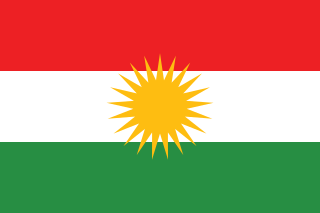
Kurdistan Region is an autonomous administrative entity within the Republic of Iraq. It comprises four Kurdish-majority divisions of Arab-majority Iraq: the Erbil Governorate, the Sulaymaniyah Governorate, the Duhok Governorate, and Halabja Governorate. The KRI is bordered by Iran to the east, by Turkey to the north, and by Syria to the west. It does not govern all of Iraqi Kurdistan, and lays claim to the disputed territories of northern Iraq; these territories have a predominantly non-Arab population and were subject to the Ba'athist Arabization campaigns throughout the late 20th century. Though the KRI's autonomy was realized in 1992, one year after Iraq's defeat in the Gulf War, these northern territories remain contested between the Kurdistan Regional Government and the Government of Iraq to the present day. In light of the dispute, the KRI's constitution declares the city of Kirkuk as the capital of Iraqi Kurdistan. However, the KRI does not control Kirkuk, and the Kurdistan Region Parliament is based in Erbil. In 2014, when the Syria-based Islamic State began their Northern Iraq offensive and invaded the country, the Iraqi Armed Forces retreated from most of the disputed territories. The KRI's Peshmerga then entered and took control of them for the duration of the War in Iraq (2013–2017). In October 2017, following the defeat of the Islamic State, the Iraqi Armed Forces attacked the Peshmerga and reasserted control over the disputed territories.
Standard Bulgarian vehicle registration plates display black glyphs on a white background, together with – on the left-hand side of the plate – a blue vertical "EU strip" showing the flag of Europe and, below it, the country code for Bulgaria: BG.

Iraq's 18 governorates are subdivided into 120 districts (kaza).
The Palestinian National Authority requires their residents register their motor vehicles and display vehicle registration plates. There are two different registration systems in use: one for West Bank and one in the Gaza Strip.
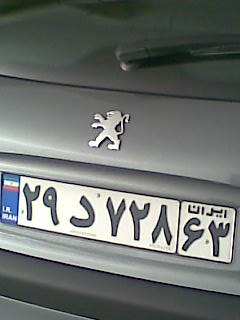
Iranian license plates have had European standard dimensions since 2005. Each province in Iran has multiple unique, two-digit codes that are included at the right end of the license plates in a distinguished square outline, above which the word ایران or "Iran" has been written. A province's license plates will not be issued with a new code unless all possible combinations with the old code have been issued. In Tehran, the first code to be issued for the province was code 11, and subsequent codes all increased by 11 as well Ever since code 99 was fully issued, the new codes for Tehran have started from 10 and subsequently increased by 10. Most province codes increased by 10 based on the first code issued for their province. Khuzestan Province, for example, has been allocated codes 24 and 14, and code 24 will not be used before code 14 is fully issued. However, as codes started getting exhausted, numbers and letters have been assigned more liberally and without following this rule of thumb anymore

The Battle ofSulaymaniyah was one of the greatest battles fought during the 1991 uprisings in Iraq. Sulaymaniyah, a mostly Kurdish city with a population of over 100,000, was the first to be liberated by the rebels and the last to fall back to the Iraqi army. The city was then recaptured by Kurdish rebels, after the Peshmerga launched a new offensive on 20 July.
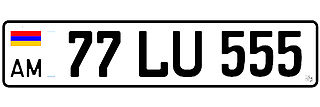
Vehicle registration plates of Armenia have black characters on a rectangular white background. They are composed of two or three numbers, two letters in the middle, and two other numbers. At the left side is located the international code "AM" with an oval car plaque and, sometimes, the national flag. Starting from 6 August 2014 a new design of license plates was implemented. The license plates have a national flag on the left side, a security hologram and a machinery readable Data Matrix Code.
Syria requires its residents to register their motor vehicles and display vehicle registration plates. Since the start of the Syrian civil war in 2011 and the fragmentation of control and governance in the Syrian territory, there has been parallel license plate formats introduced in various regions of Syria by the de facto rulers.
Kyrgyz registration plates were first issued in 1980, when the country was still a republic of the Soviet Union. Despite having gained its independence in 1991, it continued to use the old Soviet plates until the introduction of the current format in 1994.
Tajik vehicle registration plates are registration plates for vehicles registered in the country.
Vehicle registration plates of Yemen started in 1993. The current version started in 2018 using FE-Schrift typeface for alphanumeric and Square Kufic typeface for Arabic text.
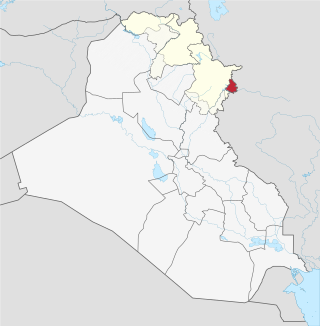
Halabja Governorate is a governorate in the autonomous region of Kurdistan Region in Iraq. The governorate was established in 2014, splitting off from Sulaymaniyah Governorate and becoming the fourth governorate in the Kurdistan Region of Iraq. Its capital is the city of Halabja. Halabja Governorate is the least populated governorate.
Subdistricts are the third-level administrative division in Iraq.

Libya requires its residents to register their motor vehicles and display vehicle registration plates. Current plates are European standard 520 mm × 110 mm.

The Erbil Civilization Museum is an archeological museum which is located within the city of Hawler, the capital of Iraqi Kurdistan. It is the second largest museum in Iraqi Kurdistan, after the Sulaymaniyah Museum in Sulaymaniyah Governorate in terms of contents and collections. It houses artifacts which date back to the pre-historic period to the late Abbasid period.